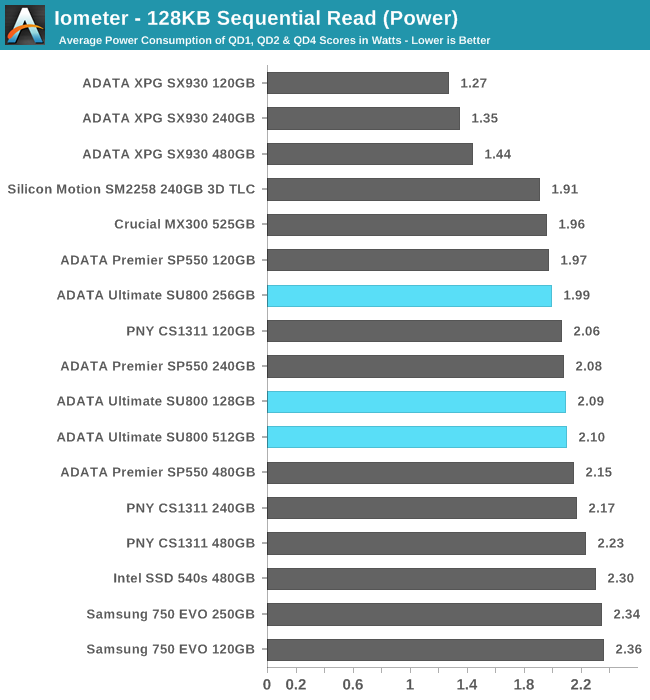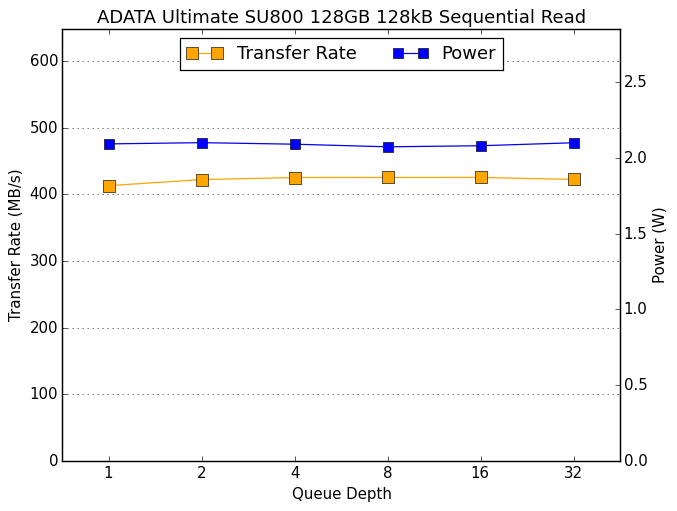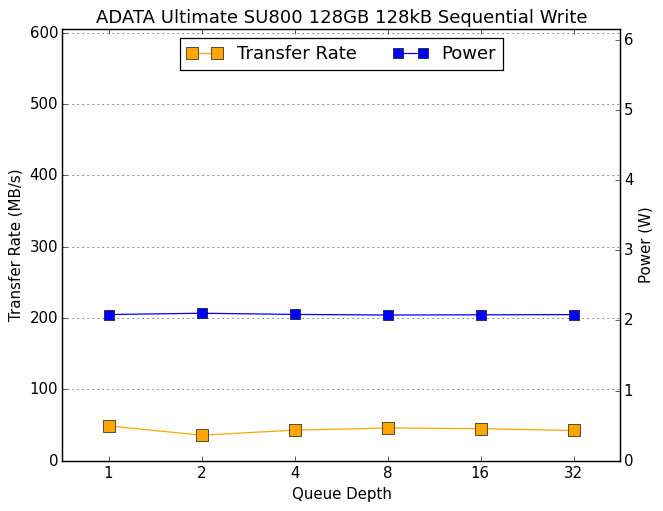The ADATA Ultimate SU800 SSD Review (128GB, 256GB, 512GB)
by Billy Tallis on February 1, 2017 12:01 PM ESTSequential Read Performance
The sequential read test requests 128kB blocks and tests queue depths ranging from 1 to 32. The queue depth is doubled every three minutes, for a total test duration of 18 minutes. The test spans the entire drive, and the drive is filled before the test begins. The primary score we report is an average of performances at queue depths 1, 2 and 4, as client usage typically consists mostly of low queue depth operations.

The smallest capacity of the ADATA SU800 has the slowest sequential read speed of all the drives in this comparison, as it only has flash connected to three of the controller's four channels. The larger SU800s saturate the SATA connection.

The SU800's power consumption is middle of the road for TLC drives, giving the larger two capacities slightly better than average efficiency. The ADATA XPG SX930 demonstrates that MLC NAND flash still has a significant efficiency advantage.
 |
|||||||||
The larger two capacities of the SU800 show modest performance improvement across the first half of the test, while the 128GB model exhibits almost no scaling.
Sequential Write Performance
The sequential write test writes 128kB blocks and tests queue depths ranging from 1 to 32. The queue depth is doubled every three minutes, for a total test duration of 18 minutes. The test spans the entire drive, and the drive is filled before the test begins. The primary score we report is an average of performances at queue depths 1, 2 and 4, as client usage typically consists mostly of low queue depth operations.

The sustained sequential write speeds of the SU800 are quite poor, but this is no surprise after seeing how much a full drive hurt performance on the ATSB Heavy and Light tests.

Power consumption is at least better than average, so the SU800 isn't too far behind the average for efficiency.
 |
|||||||||
Aside from the initial effects of filling up the SLC cache, performance and power consumption during sequential writes don't scale with queue depth on the SU800.










35 Comments
View All Comments
SaolDan - Wednesday, February 1, 2017 - link
Neat!!!MrSpadge - Wednesday, February 1, 2017 - link
Overall a worse deal than the MX300, which itself took quite some criticism. Could you elaborate on what's "neat" about this?vladx - Wednesday, February 1, 2017 - link
Price is low for decent performance. This is SATA SSD targeted towards low end and mainstream market.Great_Scott - Wednesday, February 1, 2017 - link
The MX300 is better value given the drive sizes. I'm still trying to find a replacement for the Mushkin Reactor for desktops, but the Crucial drive is my go-to for laptops currently.Arbie - Wednesday, February 1, 2017 - link
Why do you guys continually fail to mention the Mushkin Reactor 1TB MLC drive ($240 at Newegg) in your SSD comparisons? It's cheaper, faster, and probably has greater endurance.You reviewed it two years ago but have hardly mentioned it since then. It seems to be a "best buy" still.
http://www.anandtech.com/show/8949/mushkin-reactor...
But... kudos on the clickbait. You have at least as much as any other site, and of the lowest degree.
vladx - Wednesday, February 1, 2017 - link
Because Mushkin already refreshed their SSD line and the old Reactor is not manufactured anymore which means it will be gone any week now.Great_Scott - Wednesday, February 1, 2017 - link
And we will all be sad to see it go. I have a bunch of those drives, myself.Flunk - Wednesday, February 1, 2017 - link
They don't often put 2 year old drives in comparisons.Great_Scott - Wednesday, February 1, 2017 - link
That's too bad, as some context would be useful, especially considering that many people own that drive, and until recently it was still being made.Then again, a two-year-old budget drive with a very similar controller would have made the SU800 series look terrible, and we can't have that.
eek2121 - Wednesday, February 1, 2017 - link
The Mushkin Reactor is a drastically slower drive, costs about the same, and will soon disappear from retailers. It is not a competitor.